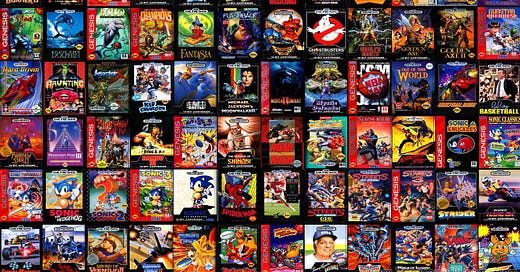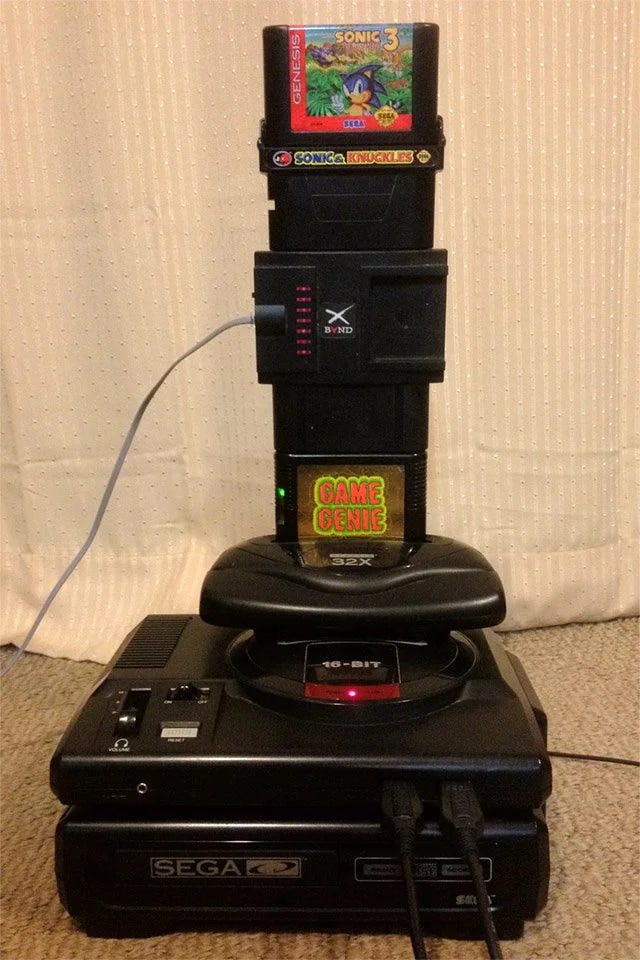That Time Writing About Old Games Nearly Destroyed Me
The 2010s feel so far away...
About ten years ago, in April 2014, I started a blog called “Sega Does.”
The goal, at the time, was to review every game ever released for a Sega console in chronological order, starting with Sega’s first relatively unknown system, the SG-1000, continuing with the Master System, Genesis, etc., and eventually ending with the Dreamcast.
“Sega Does” was born out of a desire to explore the unknown. The Sega universe was vast, full of bizarre side trails and eccentric oddities, so unlike the conservative, familiar Nintendo. I was fascinated by their reckless decision making, particularly in the mid-90s. Who were these hooligans with the audacity to release the Sega CD, 32X, Pico, and Saturn, all within three years? Couldn’t they see that it would bankrupt them if these add-ons and systems didn’t sell?
Before “Sega Does,” I had never really sat down with any Sega console, proper, and worked out what they were about. I owned a Genesis for years with one game, Sonic the Hedgehog. A great game, certainly, but after the SNES entered my life, I only had eyes for it. Eventually, I received a Dreamcast console in 2002, a gift from my friend Chip. I played Shenmue and a couple other titles and enjoyed them well enough – but by then, Sega, the console maker, was over. Playing their last system, one that had already been discontinued, felt sad and strange, the end of an era.
By early 2014, I was a tired writer. I had just finished reviewing every North American NES game on my first blog, “Questicle,” an endeavor that took a little over three years to complete. The blog was relatively successful, but I was fried. Mediocre NES games haunted my dreams, and the thought of playing any more Nintendo anything made me feel numb. I wanted to escape, go somewhere where I had no business going.
To Sega I went. From 2014-2017, I reviewed SG-1000, Master System, and Genesis games relentlessly, one after the other without fail. Sometimes I’d publish two reviews out in a week, sometimes three, depending on how short the games were. Outside of work, for three years straight, I reviewed only Sega games on my free time. Work, play, write, relax a bit at night, sleep, then repeat, was my process. Every couple of weeks, I’d record a “Sega Does” podcast with my buddy, Sam, where we’d talk about the most recent reviews. Otherwise, it was playing and writing nonstop.
Perhaps this sounds like a blast to you, but outside of the podcast and the occasional decent game, “Sega Does” felt like work. Flat-out work. I had set a goal for myself – review every game ever released for a Sega console – that seemed impossible to reach. For “Questicle,” I reviewed over 750 NES games in 3+ years. By the end, I wanted to die, I felt so depleted. So what did I do once I had reached my goal? Set an even harder goal for myself. Instead of reviewing every game released for a console in a specific territory, like North America, I’d review every game ever released for several consoles in nearly every territory. This included games in Japanese, a language I can’t understand outside of basic hiragana and katakana. All told, “Sega Does” gave me a burden of over 2,000 games to play, many of them indecipherable to me.
Why? Why would I assign myself such a horrific task?
The only answer I’ve been able to come up with over the last few years is self- validation.
“Questicle”’s popularity validated both the work that I was doing and my then-identity as a writer. Nevertheless, as “Questicle”’s purpose came to an end, I was unsure what to do with my new audience. They were there, I presumed, because I made them chuckle occasionally and for the hook. The hook being that I was one crazy guy reviewing every NES game, climbing an Everest-sized stack of cartridges and conquering them, one by one. I prevailed when so many other bloggers who had attempted the same task had failed. To keep my audience coming back, I had to keep the chuckles coming and expand the hook.
“Sega Does” was the sequel to “Questicle”: Bigger, Better, More Content, More In Your Face. Just like Sega themselves.
And I didn’t just want readers this time. I wanted more readers, all the readers. I wanted cash money success, enough to live on, enough to make my crazy blog worth its while. I was pouring so many hours of every day, every week into this thing, surely it would have to surrender and start paying off at some point.
“Sega Does” had a small loyal following, but I couldn’t keep it together. Riddled with disappointment, shame, and exhaustion, I stopped reviewing Sega games in earnest in mid-2017. Over the last seven years, I’ve returned for a month or two at a time, churned out a few reviews here and there. Sam and I even resurrected the podcast in 2023 for a brief ten-episode run. Otherwise, the site has remained largely dormant.
With “Sega Does,” my lofty goals and dreams got the better of me. I presumed that people would only read my work if I challenged myself to unhealthy levels, if I showed them I was committed to a task that most sane people would balk at. Only then would they accept me and pay me for the work I was doing. Foolish thought process, no doubt about it, but that’s how wounded people think. If the work’s not good enough, I’m not good enough, and that’s all there is to it.
I’m more grounded these days. My identity isn’t in games writing, writing in general, ambitious goals, Substack, none of that. Those things are a piece of who I am, and I enjoy them, but they’re not my core. It took years to get to this point, to realize that I don’t need others’ acceptance of my work or anything else to feel like a complete person.
Don’t get me wrong, I appreciate kind comments, hearts, well-wishes, etc. Everybody does. But if you don’t have a somewhat healthy perspective of your own self-worth, sometimes they just flat out get in the way.
I’m not opposed to reviewing more games on “Sega Does” again in the future, but I’m cautious to give myself over to it, as I once did. Reviewing all the games so that people will be interested in me and want to read my work and pay me for it… it ain’t me, babe, and it probably never was. Maybe that’s why it hurt so bad.
*images courtesy of Reddit









While I can see some value in playing and reviewing certain popular games on a console, the target of playing EVERY game on a FAILED console seems more like a Atlas quest unless it's given a specific purpose.
If you listen to Elvis' or Beatles' music, you can note the change in tone from early to mid to end. Playing all the games can give you the same sense: early games are adventurous and unique. Mid games are mature and challenging. End games are sporadic and largely horrible as they scramble to throw everything at the wall, but nothing sticks so they die.
Sometimes digging into the inner struggles of people at the company like the CEO, lead designer, or development team can reveal a lot. The behind-the-scenes politicking inside the company can also reveal why they did what they did which can be just as telling as seeing the results. It's like watching these videos of movies with so much potential lost in development hell by micromanaging production companies and producing lackluster results.
The internet and the attention economy have broken a lot of would-be “content creators,” I think. No matter what you do, there’s always someone doing it bigger, better, and more attention-grabbingly. And anything you hope to get paid for, there’s always someone giving it away.
There’s nothing wrong with just slowing down and working faithfully at your craft. We can’t all be Mr. Beast (and I suspect those who can are deeply unwell).